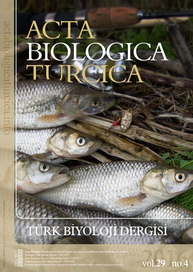Residual Efficacy of Diflubenzuron on Mosquito Larvae around Ankara province in Turkey
Abstract
The efficacy of diflubenzuron on mixed mosquito larvae (Culex sp., and Anopheles sp.) and it’s deterioration in clean aquatic system were tested in the certain intervals by the HPLC. It was determined that the diflubenzuron (20 % wettable formula) deteriorated by 30 % at the end of three months and 60 % at six months. Based on this finding, first 1,9 g (commercial product of 20 % WG) / 0,15 m2 corresponding to the standard dosage (25 g / h) applied to mixed larvae and caused 100 % mortality in 96 hrs and then the application dosage reduced by 30 percent and then applied again. It was examined that the larvae mortality was observed as 80 % in 96 hours. When the dosage reduced 60 % corresponding six months residual efficacy, no sufficient larvae mortality were observed, and therefore our finding proved that the residual effectiveness of wettable diflubenzuron lasted to 30 days in the clean surface water.
Keywords
Full Text:
PDFReferences
Adair, R.C.J.R and Mehta, N.K. 2001. Residual effects of micromite (diflubenzuron) treated citrus leaves on eggs deposited by Diaprepes abbreviatus. Proceedings of the Florida State Horticultural Society, 114:101–106.
Ascher, K.R.S and Nemy, N.E. 1976. Contact activity of diflubenzuron against Spodoptera littoralis larvae. Pesticide Science, 7:447-452.
Baruah I, and Das, S.C. 1996. Evaluation of Methoprene (Altosid) and Diflubenzuron (Dimilin) for control of mosquito breeding in Tezpur (Assam). Indian Journal of Malariology, 33: 61–66.
Caputo, B., Ienco, A., Manica, M., Petrarca, V., Rosa, R., Della Torre, A. 2015. New adhesive traps to monitor urban mosquitoes with a case study to assess the efficacy of insecticide control strategies in temperate areas. Parasite & Vectors, 8:134-156.
Djordjevic, M., Mirilovic, M., Stajkovic, N., Jankovic, L., Pešic, B., Bokonjic D. 2015. Statistical evaluation of the larvacidal effect of diflubenzuron on Culex pipiens larval stages. Acta Veterinaria, 65(4):496-509.
Grosscurt, A. C. 1978. Diflubenzuron: some aspects of its ovicidal and larvacidal mode of action and an evaluation of its practical possibilities. Pesticide Science, 9(5):373–386.
Levot G and Sales N. 2008. Resistance to benzoylphenyl urea insecticides in Australian populations of the sheep body louse. Medical and Veterinary Entomology, 22:331–334.
Maduenho, L.P., and Martinez, C.B.R. 2008. Acute effects of diflubenzuron on the freshwater fish Prochilodus lineatus. Comparative Biochemistry and Physiology Part C: Toxicology and Pharmacology, Volume 148(3):265–272.
Marrs, T.C. 2012. Toxicology of insecticides to mammals. Mini-Review Pest Manag Sci., 68(10):1332-1336.
Mulder R., and Gijswijt M.J. 1973. The laboratory evaluation of two promising new insecticides which interfere cuticle deposition. Pestic. Sci., 4:737-745.
Reynolds, S.E. 1987. The cuticle, growth and moulting in insects: the essential background to the action of acylurea insecticides. Pesticide Science 20: 131-146.
Romeo B., Alessandro A., Marco C., Roberta C., Luciano D., Maurizio M., Roberto P., Rodolfo V., Giancarlo C., Nazario, L. 2009. Efficacy and lasting activity of four IGRs formulations against mosquitoes in catch basins of northern Italy. European Mosquito Bulletin, 27:33-46.
Rozendaal, J. A. 1997. Vector Control-Methods for Use by Individuals and Communities. World health Organisation (WHO), Geneva, xii + pp 412.
Salokhe, S.G., Deshpande, S.G., Mukherjee, S.N. 2012. Evaluation of the insect growth regulator lufenuron (Match[R]) for control of Aedes aegypti by simulated field trials. Parasitology Research, 111 (3):1325.
Schroeder W.J. 1996. Diflubenzuron residue: reduction of Diaprepes abbreviatus (Coleoptera: Curculionidae) neonates. Florida Entomologist, 79:462-463.
Silva, J. J., Mendes J., Lomonaco, C. 2009. Effects of sub lethal concentrations of diflubenzuron and methoprene on Aedes aegypti (Diptera: Culicidae) fitness. International Journal of Tropical Insect Science, 29 (1): 17-23.
Van Daalen, J.J., Meltzer, J., Mulder, R., Wellinga, K. 1972. A New insecticide with a novel mode of action. Naturwissenchaften, 59, 312-313.
WHO, 2006a. Diflubenzuron. WHO specifications and evaluations for public health pesticides.
WHO, 2006b. Pesticides and their application. Sixth Edition, Department of Control and Neglected Tropical Diseases, WHO Pesticides evaluation scheme (WHOPES).
WHO, 2008. Diflubenzuron in drinking-water: Use for vector control in drinking-water sources and containers. Background document for preparation of WHO, Guidelines for drinking-water quality., Geneva.
Refbacks
- There are currently no refbacks.

